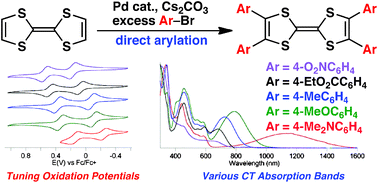Straightforward access to aryl-substituted tetrathiafulvalenes by palladium-catalysed direct C–H arylation and their photophysical and electrochemical properties†
Abstract
Treatment of

* Corresponding authors
a
Department of Chemistry, Graduate School of Science, Kyoto University, Sakyo-ku, Kyoto, Japan
E-mail:
yori@kuchem.kyoto-u.ac.jp
Fax: +81 75 753 3970
Tel: +81 75 753 4010
b Department of Material Chemistry, Graduate School of Engineering, Kyoto University, Kyoto-daigaku Katsura, Nishikyo-ku, Kyoto, Japan
c
Environment, Safety and Health Organization, Kyoto University, Sakyo-ku, Kyoto, Japan
E-mail:
oshima@orgrxn.mbox.media.kyoto-u.ac.jp
Fax: +81 75 753 7710
Tel: +81 75 753 2387
Treatment of

 Please wait while we load your content...
Something went wrong. Try again?
Please wait while we load your content...
Something went wrong. Try again?
Y. Mitamura, H. Yorimitsu, K. Oshima and A. Osuka, Chem. Sci., 2011, 2, 2017 DOI: 10.1039/C1SC00372K
To request permission to reproduce material from this article, please go to the Copyright Clearance Center request page.
If you are an author contributing to an RSC publication, you do not need to request permission provided correct acknowledgement is given.
If you are the author of this article, you do not need to request permission to reproduce figures and diagrams provided correct acknowledgement is given. If you want to reproduce the whole article in a third-party publication (excluding your thesis/dissertation for which permission is not required) please go to the Copyright Clearance Center request page.
Read more about how to correctly acknowledge RSC content.
 Fetching data from CrossRef.
Fetching data from CrossRef.
This may take some time to load.
Loading related content
